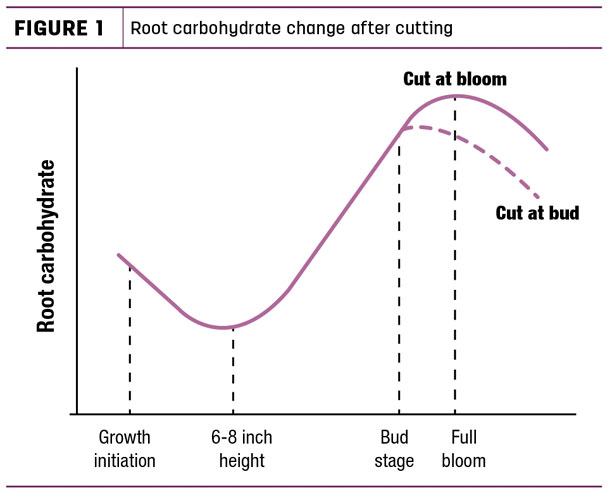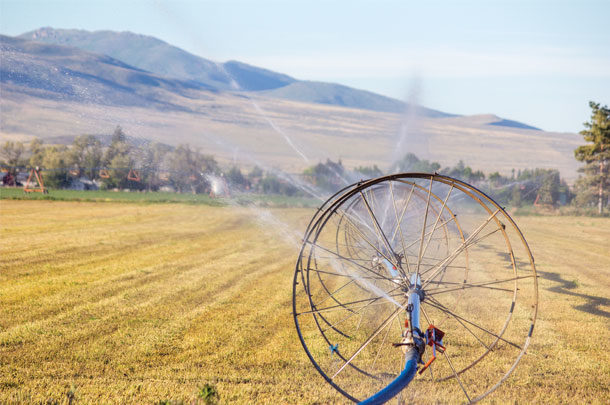We may not be thinking of winter when temperatures are 80º to 90ºF, but we should now begin preparing alfalfa for winter if we want good winter survival and high yield next spring.
First, consider whether or not the stand is worth keeping. Stem density, not plant density, determines yield potential. Fifty-five stems per square foot are required for maximum yield (25 stems per square foot in non-irrigated, dryland regions). You can count cut ends after mowing. If, for example, the stand has 40 stems per square foot, then one would expect a 25% yield reduction from maximum. If you decide to keep an irrigated stand with less than 55 stems per square foot, not only will yield be reduced, but you should consider controlling weeds, either this fall or next spring.
If keeping the stand, think now about managing alfalfa root carbohydrate levels for winter. Alfalfa uses carbohydrates stored in the root to regrow after each cutting and in the spring (Figure 1).

Typically, root carbohydrates are drawn down for about two weeks after cutting, at which time the plant has enough leaves to produce carbohydrates both to continue growth and replenish root reserves for the next regrowth cycle. Root carbohydrate concentration is maximized at full bloom. Cutting at bud stage results in as much as a 25% decrease in root carbohydrate storage. High summer temperatures can further reduce root carbohydrate concentration due to increased plant respiration.
If all cuttings of alfalfa are taken at 28-day intervals or at bud stage, root carbohydrate content is replenished to a lesser extent after each cutting. An old recommendation is to let at least one cutting (preferably the third or fourth) go to early flower to rebuild stand condition by increasing root carbohydrate levels. This is still a good idea for conventional alfalfa to improve winter survival and increase yield for first cutting next year.
It is important to point out that if one is growing HarvXtra alfalfa and harvesting on a 35-day schedule or longer, there is less need for a delayed third or fourth cutting, since more carbohydrates are placed back into the roots with the longer harvest interval at each cutting. Trials have shown better winter survival and more rapid spring greenup from 35-day cutting intervals of HarvXtra compared to continuous 28-day cutting intervals.
Lastly, regardless of alfalfa type, manage the cutting schedule so alfalfa has sufficient time to regrow after the last late summer cutting. Entering the winter with 6 to 8 inches of regrowth is the worst possible situation (see Figure 1). Where snow cover is a surety, it is possible to cut alfalfa so late that it does not regrow and use up any root carbohydrates before winter.
Second, late summer fertilization should be done to replace nutrients removed by the alfalfa forage. Each ton of alfalfa dry matter removes about 14 pounds of phosphate (P2O5), 55 pounds of potash (K2O), and 6 pounds of sulfur. Many western soils do not need additional potassium fertilization. Most dairy farms apply sufficient manure to meet phosphorus needs. All soils need sulfur, unless irrigation water content of sulfur is high. Fertilizing to replenish soil nutrients ahead of the last cutting will enhance winter survival and increase growth of first cutting next year. Remember, also, to apply 1 pound per acre of boron annually.
Third, check fields for weeds and decide whether or not a fall application of herbicide would be beneficial. Alfalfa is competitive with many weeds if a dense stand is present, but winter annual weeds can be especially problematic. They grow later in the fall and start growing early in the spring to cause stand thinning.
Some weeds, such as chickweed, can be highly competitive with alfalfa, causing stand loss and maturing ahead of alfalfa to lower the quality of first-cutting alfalfa. In addition, heavy infestations of chickweed can delay drying due to its high moisture content.
Additionally, some weeds will reduce forage palatability and have varying degrees of toxicity to cattle, horses, goats and sheep, such as yellow rocket, field pennycress, henbit, purple deadnettle, curly dock and cressleaf groundsel.
One should assess the weed problem and then plan on a fall or dormant application of herbicide to control problem weeds. In some regions, dormancy of alfalfa may be difficult to determine. Glyphosate herbicides can be applied before dormancy in the fall or during spring greenup if Roundup Ready alfalfa was planted.
Fourth, where irrigation is available, consider that the most critical irrigation is the late summer or autumn irrigation. Good levels of soil moisture at this time:
- Permit foliage regrowth and root carbohydrate accumulation for overwintering (Figure 1)
- Lessen rapid temperature changes that damage roots
- Prevent crown and root drying
- Provide stored moisture for the next growing season
Dry soils during winter often cause stand declines. Maintain soil water content between 50% to 70% of available water-holding capacity. The deeper portion of the soil profile can be refilled in this off-season period.
Lastly, it is important to fill the soil profile in late winter from either rain, snow melt or irrigation while alfalfa is dormant and before soil temperatures warm to above 60ºF. This is the period when roots begin to grow to support the aboveground growth of first harvest.
The four considerations above have science behind them that will greatly enhance alfalfa winter survival and yield next year.











